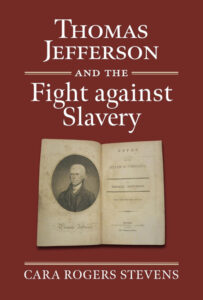BOOK REVIEW: Thomas Jefferson and the Fight Against Slavery by Cara Rogers Stevens (Lawrence, KS: University Press of Kansas, 2024. Cloth, $54.99)
Thomas Jefferson, although a mind-bogglingly prolific writer, strangely published only one book during his lifetime: Notes on the State of Virginia. From this reviewer’s experience, every mention of this book has been about a brief section that covers Jefferson’s racist beliefs concerning the physical attributes of African American slaves compared to those of the Caucasian race. The section confirms what most people know: that Jefferson, the writer who included the idea that “all men are created equal” in the Declaration of Independence, was a hypocrite who not only owned slaves but justified their condition based on his “bunk” science. Cara Rogers Stevens, however, has published a book that completely changes the narrative regarding Notes on the State of Virginia. In her Thomas Jefferson and the Fight Against Slavery, Stevens maintains that Jefferson’s book was a contribution to the antislavery cause. Although best known for its white-supremacist attitudes on racial differences, careful study of Notes “demonstrates that over a period of several years Jefferson became increasingly determined to clarify his views in order to strengthen his condemnation of slavery” (page 3).
 The intended audience of what became Notes was the student body of the College of William and Mary, Jefferson’s alma mater. Specifically, it was for those students who would later take up leadership positions in the Virginia legislature. Notes, written between 1780 and 1785 in Virginia, Maryland, Pennsylvania and Paris, started off as answers to a list of queries about Virginia that Jefferson received from Francois, marquis de Barbe-Marbois. When Jefferson was in Paris representing the new United States, he focused on his manuscript to deal with grief over his recently deceased wife Martha. He received encouragement from the Marquis de Chastellux and congressional secretary Charles Thomson. Thomson wrote to Jefferson that the pieces about the perceived (and widely accepted at the time) inferiorities of the African race were used to justify slavery. Jefferson took those concerns to heart and included his racist sentiments as a way to explain his antislavery views.
The intended audience of what became Notes was the student body of the College of William and Mary, Jefferson’s alma mater. Specifically, it was for those students who would later take up leadership positions in the Virginia legislature. Notes, written between 1780 and 1785 in Virginia, Maryland, Pennsylvania and Paris, started off as answers to a list of queries about Virginia that Jefferson received from Francois, marquis de Barbe-Marbois. When Jefferson was in Paris representing the new United States, he focused on his manuscript to deal with grief over his recently deceased wife Martha. He received encouragement from the Marquis de Chastellux and congressional secretary Charles Thomson. Thomson wrote to Jefferson that the pieces about the perceived (and widely accepted at the time) inferiorities of the African race were used to justify slavery. Jefferson took those concerns to heart and included his racist sentiments as a way to explain his antislavery views.
There was an antislavery movement in Virginia since the 1760s, and many people were looking for alternatives to the institution, which had a corrupting influence on Virginians themselves. Jefferson believed in a form of sharecropping that would be adopted by European immigrants as one solution. He also advocated the idea of colonization, of sending freed blacks to Africa. Since all men were created equal, he believed, these emigrants would create their own sovereign state in Africa. When Jefferson was in Paris, he was optimistic about an antislavery future in the US. Stevens focuses on the relationship that Jefferson had with his private secretary in Paris, William Short. Short almost became Jefferson’s adopted son in the same way that Lafayette was Washington’s. Over time, however, Short’s views on slavery diverged from those of Jefferson, and he became much more radical in his outlook.
Stevens writes about how Notes on the State of Virginia had a lasting effect on Jefferson’s followers and Virginia’s future politicians, as Jefferson intended. St. George Tucker, a William and Mary professor and judge, worked with Jefferson regarding Virginia’s slavery laws. Tucker’s cousin, George Tucker, continued with efforts to push for antislavery motions. Edward Coles, who was James Madison’s secretary, and future Gen. Winfield Scott were both influenced by Notes. Chapter 6 of Stevens’ book, “The Jeffersonian Legacy in Virginia 1820-1832,” included profiles of Jefferson’s relatives and enslaved people after his death. Some tried to keep enslaved families together, which was impossible because the former president left his family in dire financial straits.
Thomas Jefferson, although he did not claim that Black and White people could live together peacefully (a falsehood that he was aware of because of his relationship with Sally Hemings), still firmly believed in the idea that Blacks did have rights. Whether Notes succeeded in enforcing this idea is for the reader of Thomas Jefferson and the Fight Against Slavery to determine. The book ends with this reality check:
Just as Jefferson had hoped, later generations of Americans embraced liberty even more than many in his own generation could. As moral standards improved over time, public opinion advanced. And laws changed. The “ball of liberty,” which Jefferson helped “first put . . . into motion,” continues its “roll round the globe.” (p. 255)
PLEASE CONSIDER PURCHASING THIS BOOK FROM AMAZON IN HARDCOVER OR KINDLE.
(As an Amazon Associate, JAR earns from qualifying purchases. This helps toward providing our content free of charge.)





Recent Articles
New Jersey’s Revolutionary Rivalry
The Evolution of the American Declaration of Independence
The Deadliest Seconds of the War
Recent Comments
"The Evolution of the..."
This article is a gem. Sparkling. Excellent research. Wide and deep. Thank...
"The Evolution of the..."
A very interesting article, thank you! A more general question, if you...
"The Evolution of the..."
Thoroughly researched and a succinct presentation, especially given the article's breadth.